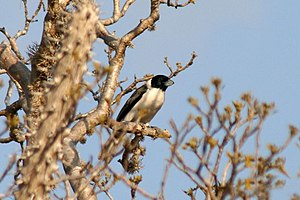Narrow-billed vanga
| Narrow-billed vanga | ||||||||||||
|---|---|---|---|---|---|---|---|---|---|---|---|---|

Narrow-billed vanga ♂ |
||||||||||||
| Systematics | ||||||||||||
|
||||||||||||
| Scientific name | ||||||||||||
| Xenopirostris xenopirostris | ||||||||||||
| ( Lafresnaye , 1850) |
The narrow- billed vanga ( Xenopirostris xenopirostris ) is a passerine bird in the family of the Vangawurger (Vangidae). This monotypical species lives in Madagascar and is endemic there . The IUCN classifies the population as Least Concern .
features
The Schmalschnabelvanga reaches a body length of about 24 centimeters. The male's cap, ear-coverts, and chin are glossy black. The top is separated by a white throat band. The mantle (area between the neck and shoulder feathers), the shoulders, the upper wing-coverts and the tail are ash gray with brown tones, with the wing feathers being a bit darker and brown. The tail is grayish brown throughout. Unlike the chin, the underside is colored dirty white. The iris is dark brown. The distinctive bluish white beak sometimes has a dark spot at the tip and appears narrow and globular. When it is closed, there is a small gap between the upper and lower beak. The legs are dark gray-blue. The female differs from the male in that the reins and front parting are white-gray, the cheeks are white and the top is ash-gray and brown. The young birds are similar to the females, but have a brown top.
behavior
They are mostly seen in pairs and often they even mingle with mixed Vanga groups. They look for their food in the corners and niches of dead or broken wood, especially under dead tree bark and branches. Their prey includes large insects and smaller vertebrates. They usually build their goblet-shaped nests in tree forks.
distribution and habitat
They occur exclusively in the southern semi-desert climate of Madagascar. There they can be found north of the Mangoky River to the east of the city of Tolagnaro at altitudes between sea level and 100 meters. They prefer thorny primary forest and coastal milkweed bushes, as well as their adjacent human-destroyed surroundings.
Etymology and history of research
Frédéric de Lafresnaye first described the bird under the name Vanga xenopirostris . As part of the article, an illustration of the striking beak appeared. It was only later that V. xenopirostris of the genus Xenopirostris Bonaparte of the same name was added in 1850.
The word "Xenopirostris" is made up of the Greek word "xenos" for "strange, strange" and the Latin word "rostris" for "-beaked".
literature
- Peter Morris, Frank Hawkins: Birds of Madagascar: A Photographic Guide. Yale University Press, 1998, ISBN 0-300-07755-6 .
- Frédéric de Lafresnaye: Sur le genre Vanga, note suivie, de la description du Vanga xenopirostris et de L'Anabate nigro-pectus. Revue et Magasin de Zoologie Pure et Appliquée Series 2, Vol 2 1850, pp. 104–108 Original article (French)
- James A. Jobling: Helm Dictionary of Scientific Bird Names. Christopher Helm Publishers Ltd, 2009, ISBN 978-1-4081-2501-4 . book
Individual evidence
Web links
- Xenopirostris xenopirostris in the Red List of Threatened Species of the IUCN 2011.2. Listed by: BirdLife International, 2009. Retrieved December 23, 2011.
- BirdLife International: Species Factsheet - Lafresnaye's Vanga ( Xenopirostris xenopirostris ) . Retrieved December 23, 2011.
- Videos, photos and sound recordings of Lafresnaye's Vanga (Xenopirostris xenopirostris) in the Internet Bird Collection
- Narrow-billed vanga ( Xenopirostris xenopirostris ) at Avibase; Retrieved January 10, 2012.
- Xenopirostris xenopirostris in the Integrated Taxonomic Information System (ITIS)
- xeno-canto: Sound recordings - Lafresnaye's Vanga ( Xenopirostris xenopirostris )
